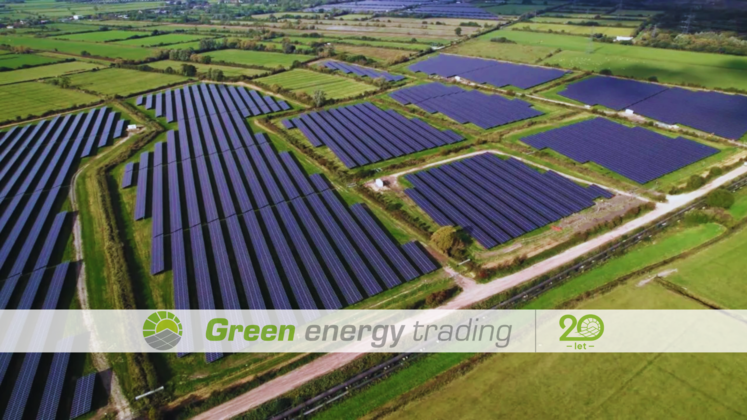A detailed look at solar farms
 2. 9. 2025
2. 9. 2025
Solar farms are large ground-mounted solar installations that occupy large areas of open space and provide clean energy generated from the sun.
By large installations, we mean solar installations with a capacity in the megawatt range. To give you an idea, a one-megawatt solar farm is equivalent to approximately 166 home solar systems!
Using photovoltaic (PV) panels, solar farms harness the sun's energy and convert it into electricity, which is sent to the electrical grid for distribution and consumption. Sometimes solar farms use different solar technologies to generate electricity, such as concentrated solar power systems.
Solar farms can cover several hectares and are sometimes called solar parks. You can think of solar farms as a greener version of traditional fossil fuel power plants, which are designed to produce large amounts of energy.
How do solar farms work?
Most solar farms use solar panels to convert sunlight into electricity. Solar energy hits the surface of the solar panel and releases electrons, creating an electric current. This is then converted by an inverter into electricity that can be used by homes and businesses.
There are two main types of solar farms: utility farms and community solar farms.
Utility solar farms
These are similar to other power plants that supply energy directly to the electrical grid. These huge solar parks, which are usually built by developers under long-term contracts, produce energy that is sold at wholesale prices and distributed to customers via power lines.
These installations can range in capacity from 1 megawatt (MW) to an incredible 2,000 MW and are among the largest projects in the solar industry.
Community solar projects
Community solar farms are typically 5 MW or less in size and are designed to supply energy to customers or members who pay a share of the system.
The solar energy used from this share is usually cheaper than the retail price of electricity, which saves customers money on their electricity bills. Community solar energy is intended for tenants and homeowners who cannot install solar panels, or low-income residents who are interested in solar energy.
How does a solar farm differ from a rooftop solar power plant?
Although both use solar energy to generate electricity, there are fundamental differences in how solar farms and rooftop solar power plants work. These differences are outlined below:
Due to economies of scale, solar farms have lower costs per watt than rooftop solar installations. However, due to their enormous size, the total cost of a solar farm is much higher.
One of the biggest differences between solar farms and rooftop solar installations is how the energy is used. Solar electricity generated by solar farms is distributed to hundreds or even thousands of people. Rooftop solar panels are designed to supply energy directly to the building on which they are installed.
The two types also differ in how they are installed: solar farms are usually ground-mounted systems of 1 MW or more, while rooftop systems are mounted directly on the roof and are typically between 4 and 20 kW in size. Solar farms also use larger solar panels with a capacity of at least 500 watts. Home solar installations typically use smaller panels with a capacity of between 350 and 450 watts.
Advantages of solar farms
Zero emissions: Solar farms are an excellent way to distribute electricity to the grid without fossil fuels or releasing harmful emissions into the atmosphere, as is the case with typical power plants, contributing to the fight against climate change and reducing carbon footprints.
Low operating costs: Solar farms are largely self-sufficient and do not require as much maintenance or supervision as other power plants, resulting in lower operating costs.
Cheaper energy source: Generating electricity from solar energy is more cost-effective than other energy sources, such as fossil fuels or geothermal energy.
Increases the availability of solar energy: There are solar farms designed for community solar programs that are available to people who do not typically have the ability to use solar energy, such as renters or low-income homeowners.
Renewable energy source: Solar energy is considered renewable because, unlike fossil fuels, its use does not deplete the energy source.
Flexible design and location: Solar panels on roofs are limited by the design of the house or business on which they are installed, while solar farms have a little more flexibility in creating a system that ensures optimal solar energy production.
Disadvantages of solar farms
May have an impact on the surrounding area: Because solar farms are so large, they can negatively affect the ecosystems in which they are installed. They can potentially affect the migration routes of some animals or exacerbate the effects of soil erosion during installation.
Aesthetics: Solar farms take up huge areas of land, which some may find unsightly.
Intermittent energy source: Even if your solar farm is unshaded, the amount of energy that solar panels produce is still dependent on the weather. Energy production can be inconsistent due to the intensity of sunlight, which varies depending on location, season, and time of day.
High initial costs: Although solar energy for large installations has a lower cost per watt than solar energy for households, the sheer size of a solar farm represents a significant investment, with construction costs reaching millions of dollars. Developers or contractors who do not consider solar energy a priority as an energy source may not be willing to invest in a project of this scale.
Is it worth building a solar farm?
However, for large investors and contractors, building solar farms is worthwhile in order to move away from fossil fuels and provide clean energy for the entire country.
Solar farms used for community solar projects are also a great way to expand access to solar energy, as they allow tenants, low-income families who cannot afford installation, or homeowners who live in locations unsuitable for rooftop solar panels to use solar energy.
